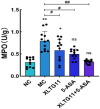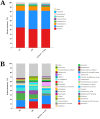Amelioration of inflammatory bowel disease by Bifidobacterium animalis subsp. lactis XLTG11 in combination with mesalazine
- PMID: 39697653
- PMCID: PMC11652597
- DOI: 10.3389/fmicb.2024.1472776
Amelioration of inflammatory bowel disease by Bifidobacterium animalis subsp. lactis XLTG11 in combination with mesalazine
Abstract
The treatment of inflammatory bowel disease (IBD) remains challenging and significantly impacts both patients and their families. This study evaluated the role of Bifidobacterium animalis subsp. lacti XLTG11 (XLTG11) in combination with mesalazine (5-ASA) in the improvement of IBD. The results demonstrated that the XLTG11+5-ASA group exhibited superior recovery compared to both the XLTG11-only group and the 5-ASA-only group. The XLTG11+5-ASA group significantly reduced myeloperoxidase activity (MPO), attenuated colonic tissue damage, lowered the levels of lipopolysaccharides (LPS) and D-lactic acid (D-LA), and decreased intestinal permeability. Furthermore, it upregulated the mRNA expression of Claudin-1, Occludin, ZO-1, and MUC2, which contributed to the protective effect on intestinal barrier function. Additionally, the XLTG11+5-ASA group significantly increased the levels of anti-inflammatory cytokines while decreasing pro-inflammatory cytokine levels. Notably, treatment with the XLTG11+5-ASA group significantly increased levels of acetic, propionic, and butyric acids, as well as the relative abundance of beneficial bacteria such as Bifidobacterium and Lactobacillus, while decreasing the relative abundance of Enterococcus, Enterobacteriaceae, and Clostridium perfringens. The results indicate that the combination of XLTG11 and 5-ASA was more effective in treating IBD than either treatment alone, significantly improving IBD-related symptoms and providing a scientific basis for future clinical applications.
Keywords: Bifidobacterium animalis subsp. lacti; IBD; SCAFs; intestinal microorganisms; mesalazine.
Copyright © 2024 Ma, Wu, Lin, Yang and Huang.
Conflict of interest statement
The authors declare that the research was conducted in the absence of any commercial or financial relationships that could be construed as a potential conflict of interest.
Figures








Similar articles
-
Bifidobacterium animalis subsp. lactis XLTG11 improves antibiotic-related diarrhea by alleviating inflammation, enhancing intestinal barrier function and regulating intestinal flora.Food Funct. 2022 Jun 6;13(11):6404-6418. doi: 10.1039/d1fo04305f. Food Funct. 2022. PMID: 35616024
-
Alleviation Effects of Bifidobacterium animalis subsp. lactis XLTG11 on Dextran Sulfate Sodium-Induced Colitis in Mice.Microorganisms. 2021 Oct 3;9(10):2093. doi: 10.3390/microorganisms9102093. Microorganisms. 2021. PMID: 34683415 Free PMC article.
-
Combination of Lactobacillus acidophilus and Bifidobacterium animalis subsp. lactis Shows a Stronger Anti-Inflammatory Effect than Individual Strains in HT-29 Cells.Nutrients. 2019 Apr 27;11(5):969. doi: 10.3390/nu11050969. Nutrients. 2019. PMID: 31035617 Free PMC article.
-
Bifidobacterium animalis subsp. lactis HN019 Effects on Gut Health: A Review.Front Nutr. 2021 Dec 14;8:790561. doi: 10.3389/fnut.2021.790561. eCollection 2021. Front Nutr. 2021. PMID: 34970580 Free PMC article. Review.
-
Development, validation and implementation of an in vitro model for the study of metabolic and immune function in normal and inflamed human colonic epithelium.Dan Med J. 2015 Jan;62(1):B4973. Dan Med J. 2015. PMID: 25557335 Review.
Cited by
-
The effects of Bifidobacterium animalis QC08 on reducing uric acid level and providing renal protection in mice with hyperuricemia.Front Microbiol. 2025 Jan 30;16:1529626. doi: 10.3389/fmicb.2025.1529626. eCollection 2025. Front Microbiol. 2025. PMID: 39949621 Free PMC article.
References
LinkOut - more resources
Full Text Sources
Research Materials
Miscellaneous

